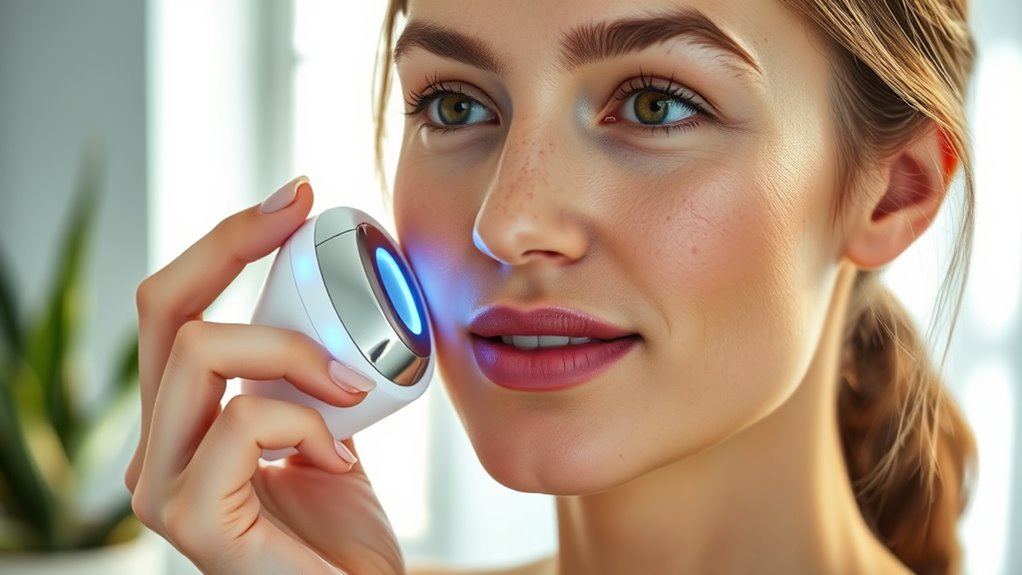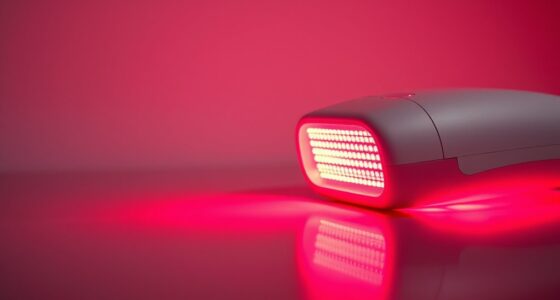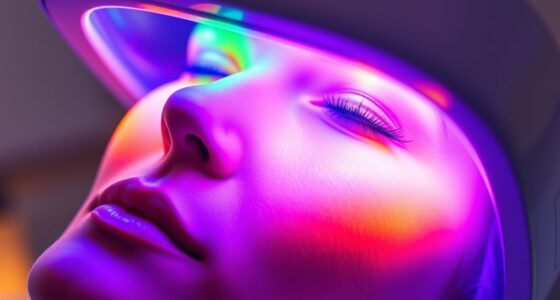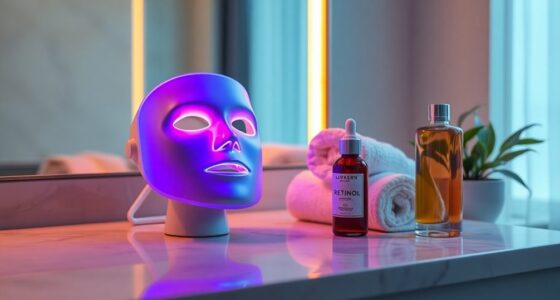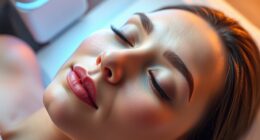To avoid sabotaging your LED acne treatment results, you need to follow proper protocols and stay consistent. Don’t ignore side effects or rush treatments—these can lead to irritation or less effective outcomes. Make sure you cleanse your skin beforehand, stick to the recommended treatment schedule, and use the correct light settings. Over- or underusing devices and skipping steps can slow progress. Keep learning how to optimize your routine for the best results—there’s more to discover.
Key Takeaways
- Follow manufacturer guidelines for treatment frequency and duration to ensure effectiveness and prevent skin irritation.
- Be patient and consistent, completing the full recommended course before expecting noticeable results.
- Properly cleanse your skin before each session to enhance light absorption and reduce side effects.
- Understand specific LED wavelengths and protocols to target your skin concerns accurately and safely.
- Recognize that temporary side effects are normal; avoid rushing or stopping treatment prematurely to avoid suboptimal results.
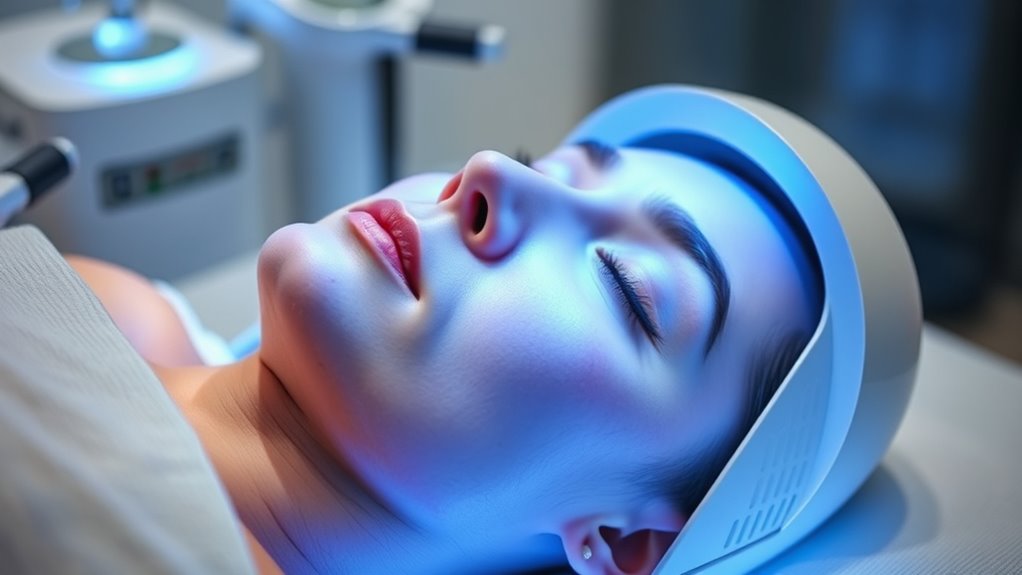
While LED acne treatments can effectively clear your skin, many people unknowingly sabotage their results by making common mistakes. One of the most overlooked pitfalls involves not understanding the potential side effects and how they relate to the treatment duration. Some individuals start treatment expecting immediate results and ignore the possible side effects that might occur, such as redness, dryness, or irritation. These side effects are often temporary, but if you ignore them or push through without adjustments, they can turn into more substantial issues that hinder progress. Knowing that LED therapy typically requires a consistent treatment schedule over several weeks helps set realistic expectations, preventing premature discontinuation or unnecessary concern over mild side effects.
Another mistake is not adhering to the recommended treatment duration. Many users assume that shorter or irregular sessions will save time, but this can greatly diminish the therapy’s effectiveness. LED acne treatments usually need multiple sessions over a span of weeks to produce noticeable improvements. Skipping sessions or stopping treatment early can lead to subpar results, forcing you to restart the process and prolong your acne struggles. Consistency is key, and understanding that a full treatment course often lasts around four to eight weeks helps you stay committed and patient, maximizing the benefits while minimizing wasted time and effort.
Failing to follow the prescribed protocol also increases the risk of side effects. For example, using the device more frequently than recommended may lead to increased irritation or sensitivity, which can set back your progress. Overusing LED therapy doesn’t necessarily speed up results and can make your skin more reactive. Conversely, using it too infrequently might delay improvements. Reading and following the manufacturer’s guidelines ensures you strike the right balance, reducing the likelihood of adverse side effects and optimizing the treatment duration for best results.
Additionally, neglecting to prepare your skin properly before treatments can worsen side effects and extend the overall treatment duration. Cleansing your face thoroughly before each session clears away dirt, oil, and makeup, allowing the LED light to penetrate better and reduce the chance of irritation. Failing to do so might cause unnecessary redness or breakouts, which can be mistaken for side effects and tempt you to alter your routine improperly.
Another important aspect is understanding that different LED light wavelengths target various skin concerns and require specific settings or durations for optimal results. In essence, understanding the relationship between side effects and treatment duration is vital. Being patient, adhering to guidelines, and listening to your skin’s responses will help you avoid common mistakes that undermine your LED acne therapy. Proper management of side effects and consistent treatment over the recommended duration will give you the best chance at clear, healthy skin.
Frequently Asked Questions
Can LED Therapy Worsen Acne if Misused?
If you misuse LED therapy, it can worsen acne, especially if you don’t consider the right LED wavelength for your skin. Using an inappropriate wavelength may irritate sensitive skin or increase inflammation, making acne worse. Be mindful of your skin sensitivity and follow recommended guidelines. Overuse or incorrect settings can lead to adverse effects, so always consult with a professional to guarantee safe and effective treatment.
How Long Before I See Results From LED Treatments?
Did you know that most people see visible improvements from LED acne treatments within 4 to 6 weeks? Your treatment duration plays a key role in results, so patience is vital. You might notice changes after a few sessions, but consistent use is essential for lasting effects. Keep in mind, individual responses vary, and sticking to your schedule helps guarantee you achieve the best possible outcome.
Are There Skin Types That Shouldn’T Use LED Therapy?
Some skin types may not be suitable for LED therapy due to skin compatibility issues or treatment contraindications. If you have sensitive skin, rosacea, or active infections, LED treatments might cause irritation or worsen your condition. Always consult with a dermatologist beforehand to evaluate your skin’s compatibility, ensuring there are no treatment contraindications. This step helps you safely enjoy the benefits of LED therapy without risking adverse effects.
What Should I Do if I Experience Side Effects?
If you experience side effects during LED acne treatment, stop the session immediately. Review your skincare routines to guarantee you’re not using products that may cause irritation or interact negatively with the therapy. Consult your dermatologist to determine if you should adjust your skincare routine or avoid certain products. Always follow professional advice to prevent complications and maximize your treatment results. Remember, proper skincare routines and awareness of product interactions are key to safe, effective outcomes.
Is LED Therapy Safe During Pregnancy?
During pregnancy, you’re right to ask if LED therapy is safe. Generally, LED treatments are considered safe when following pregnancy precautions, but it’s best to consult your healthcare provider first. They can recommend safe treatment options tailored to your needs. While LED therapy doesn’t involve harmful UV rays, always verify the practitioner is experienced and uses approved devices to protect you and your baby.
Conclusion
By avoiding these seven mistakes, you’re taking control of your acne journey. Think of it as steering a ship—every correct move keeps you on course, while small errors can cause setbacks. Even when progress slows, remember that patience and consistency matter more than quick fixes. Don’t let avoidable mistakes steer you off track; instead, stay committed, learn from setbacks, and trust that steady effort will lead you to clearer, healthier skin.
